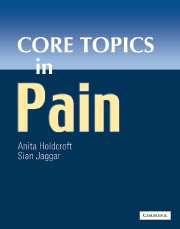Book contents
- Frontmatter
- Contents
- Contributors
- Preface
- Acknowledgements
- Foreword
- General abbreviations
- Basic science abbreviations
- PART 1 BASIC SCIENCE
- 1 Overview of pain pathways
- 2 Peripheral mechanisms
- 3 Central mechanisms
- 4 Pharmacogenomics and pain
- 5 Peripheral and central sensitization
- 6 Inflammation and pain
- 7 Nerve damage and its relationship to neuropathic pain
- 8 Receptor mechanisms
- PART 2 PAIN ASSESSMENT
- Section 2a Pain measurement
- Section 2b Diagnostic strategies
- PART 3 PAIN IN THE CLINICAL SETTING
- Section 3a Clinical presentations
- Section 3b Pain syndromes
- PART 4 THE ROLE OF EVIDENCE IN PAIN MANAGEMENT
- PART 5 TREATMENT OF PAIN
- Section 5a General Principles
- Section 5b Physical treatments
- Section 5c Pharmacology
- Section 5d Psychosocial
- PART 6 SUMMARIES
- Glossary
- Index
6 - Inflammation and pain
from PART 1 - BASIC SCIENCE
Published online by Cambridge University Press: 10 December 2009
- Frontmatter
- Contents
- Contributors
- Preface
- Acknowledgements
- Foreword
- General abbreviations
- Basic science abbreviations
- PART 1 BASIC SCIENCE
- 1 Overview of pain pathways
- 2 Peripheral mechanisms
- 3 Central mechanisms
- 4 Pharmacogenomics and pain
- 5 Peripheral and central sensitization
- 6 Inflammation and pain
- 7 Nerve damage and its relationship to neuropathic pain
- 8 Receptor mechanisms
- PART 2 PAIN ASSESSMENT
- Section 2a Pain measurement
- Section 2b Diagnostic strategies
- PART 3 PAIN IN THE CLINICAL SETTING
- Section 3a Clinical presentations
- Section 3b Pain syndromes
- PART 4 THE ROLE OF EVIDENCE IN PAIN MANAGEMENT
- PART 5 TREATMENT OF PAIN
- Section 5a General Principles
- Section 5b Physical treatments
- Section 5c Pharmacology
- Section 5d Psychosocial
- PART 6 SUMMARIES
- Glossary
- Index
Summary
Inflammation and pain
Tissue injury, irritation or infection can induce inflammation. The classical observations of redness (rubor), heat (calor) and swelling (tumour), are invariably accompanied by pain (dolor). Each reaction contributes to the prevention of further insult and the resolution of damaged tissue. Post—operative pain exhibits the classical features of inflammatory pain. In some disease states, such as arthritis, the inflammation persists and causes chronic inflammatory pain. Inflammation and inflammatory pain are mediated by a plethora of diverse substances released by tissue damage itself and the subsequent cascade of inflammatory processes. Some inflammatory mediators directly activate and sensitize primary (1°) afferent nerve fibres (C and Aδ). Others stimulate the release of further mediators from immune cells, attracted by yet other chemicals in the inflammatory ‘soup’, which is a term used to refer collectively to all the pro-inflammatory mediators. Immune cells are recruited to the site of injury and act as a potent source of growth factors and cytokines. These are important in the generation and maintenance of hyperalgesia. This system exhibits enormous potential for interaction and escalation between each of the contributing processes. The polymorphonu-clear leucocyte, of which the neutrophil is most plentiful, appears to be the principle immune cell involved in the generation of inflammatory pain.
- Type
- Chapter
- Information
- Core Topics in Pain , pp. 37 - 42Publisher: Cambridge University PressPrint publication year: 2005



